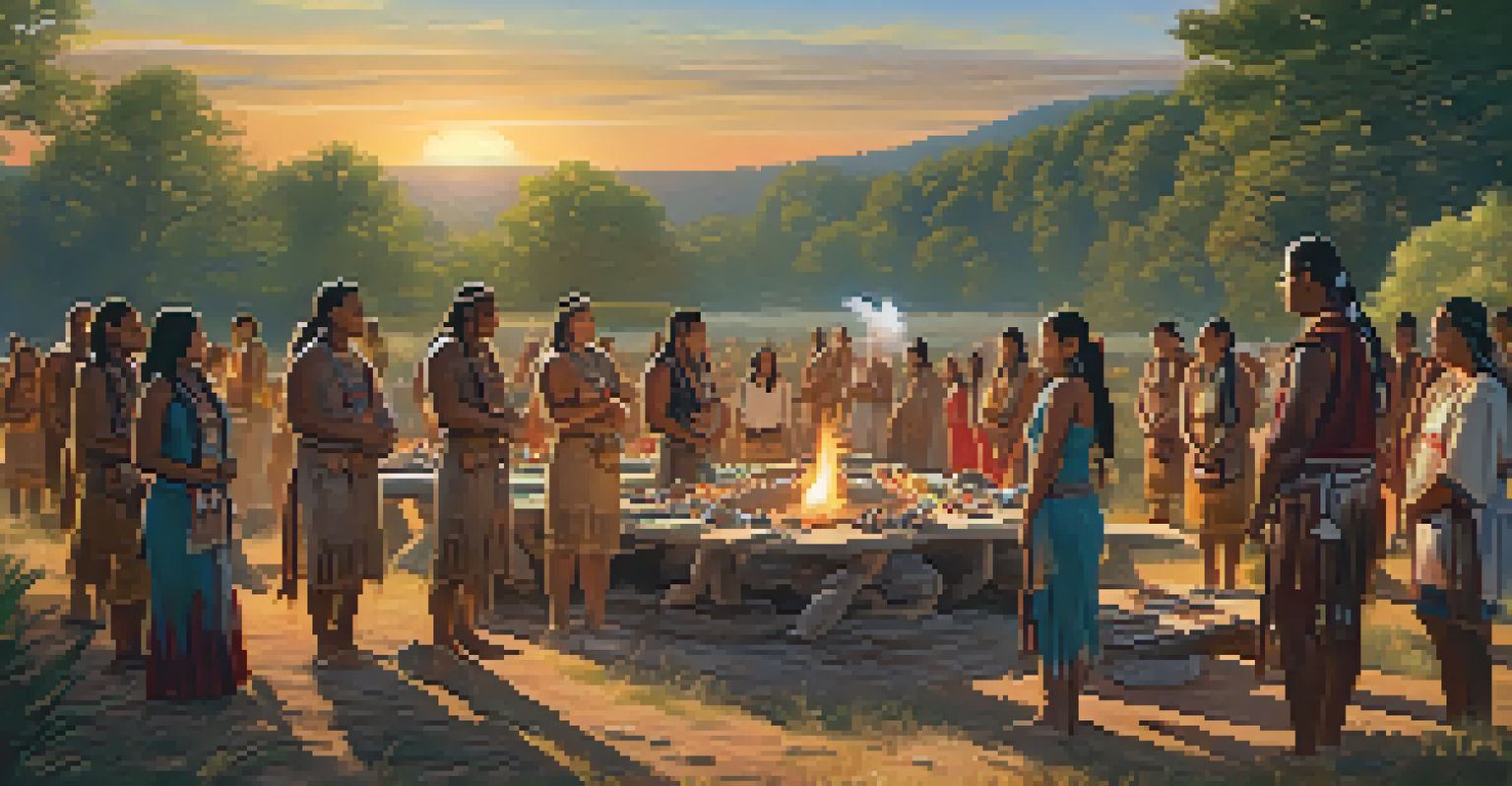Spirituality and Gender: The Role of Peyote in Native Practices

Understanding Spirituality in Native Cultures
Spirituality among Native cultures often intertwines with nature, community, and personal identity. It's not just about individual beliefs; it's deeply rooted in collective experiences and traditions passed down through generations. This holistic approach emphasizes interconnectedness, reflecting a worldview that sees humans as part of a larger ecosystem.
Spirituality is not a destination but a journey that unfolds in community and connection with the natural world.
In many Native communities, spirituality is a way of life, guiding daily practices, rituals, and relationships. For instance, ceremonies are conducted to honor the earth, ancestors, and the spiritual beings that inhabit their world. This reverence fosters a sense of belonging and purpose, which is crucial for both individual and communal well-being.
Peyote, a psychoactive cactus, plays a significant role in these spiritual practices. As a sacrament in various Native American religions, it facilitates a deeper connection to the spiritual realm, offering insights and healing. The use of peyote highlights the importance of sacred plants in spiritual rituals, reinforcing the bond between spirituality and the natural world.
The Role of Peyote in Indigenous Spirituality
Peyote is more than just a plant; it is a powerful symbol of spiritual awakening and transformation. Many Native American tribes, including the Huichol and the Lakota, incorporate peyote into their religious ceremonies to seek guidance, wisdom, and healing. The experience of consuming peyote can lead to profound insights and a sense of unity with the universe.

During ceremonies, participants often engage in prayer, singing, and storytelling, creating a sacred space for shared experiences. This communal aspect emphasizes the collective nature of spirituality, where individuals support each other on their spiritual journeys. The ritual use of peyote reinforces the idea that spirituality is not solely an individual pursuit but a communal one.
Spirituality is Community-Centric
In Native cultures, spirituality is deeply intertwined with community, emphasizing collective practices and relationships.
Furthermore, peyote ceremonies can serve as a means of cultural preservation, allowing younger generations to connect with their heritage. By participating in these rituals, individuals gain a deeper understanding of their identity and the historical significance of their traditions. This connection to the past is vital in cultivating a sense of pride and belonging within Native communities.
Gender Roles in Native Spiritual Practices
Gender plays a crucial role in Native spirituality, influencing who participates in ceremonies and how they engage with sacred practices. Traditionally, many Native cultures have recognized the importance of both masculine and feminine energies, viewing them as complementary forces. This balance is essential for maintaining harmony within the community and the natural world.
To understand the true essence of Native spirituality, one must recognize the importance of culture, community, and the sacredness of all living things.
In specific ceremonies, men and women may have distinct roles, reflecting their unique contributions to the spiritual experience. For instance, while men might lead certain rituals, women often play vital roles in nurturing the community and preserving traditions. This division of roles does not imply inequality but rather highlights the importance of diverse perspectives in spiritual practices.
As contemporary discussions around gender evolve, some Native communities are re-examining and redefining these roles. This shift acknowledges the fluidity of gender and the inclusion of Two-Spirit individuals, who embody both masculine and feminine characteristics. Embracing this diversity can enrich spiritual practices and foster a more inclusive environment.
Two-Spirit Identity and Peyote Rituals
The Two-Spirit identity is a unique concept within many Native cultures, representing individuals who embody both male and female qualities. This identity challenges conventional gender norms, offering a more nuanced understanding of gender in spiritual contexts. Two-Spirit individuals often play significant roles in ceremonies, acting as bridges between the physical and spiritual realms.
In the context of peyote rituals, Two-Spirit individuals may serve as healers or spiritual guides, utilizing their unique perspectives to enrich the experience for all participants. Their presence underscores the importance of inclusivity in spiritual practices, recognizing that diverse identities contribute to a more profound communal experience. This inclusivity is essential for fostering understanding and acceptance within the community.
Peyote's Role in Healing and Unity
Peyote serves as a sacrament in rituals, facilitating healing and a sense of unity among participants in Native spiritual practices.
The integration of Two-Spirit individuals into peyote ceremonies also reflects a broader movement toward reclaiming traditional roles and narratives. This reclamation allows for a deeper exploration of gender fluidity within Indigenous spirituality, demonstrating how these practices can evolve while remaining rooted in cultural heritage. As a result, Two-Spirit identities enhance the richness of Native spiritual traditions.
The Healing Aspects of Peyote in Gendered Contexts
Healing is a fundamental aspect of spirituality in Native cultures, often facilitated by the use of peyote. The sacrament is believed to provide not only physical healing but also emotional and spiritual restoration. This holistic approach to healing is especially significant for individuals grappling with issues related to gender identity and expression.
For many, peyote ceremonies offer a safe space to explore personal struggles and find solace in shared experiences. Participants often report feelings of empowerment and acceptance as they confront their challenges in a supportive environment. This healing process can be transformative, enabling individuals to embrace their identities more fully.
Moreover, the communal nature of these ceremonies fosters connections among participants, reinforcing the idea that healing is a collective journey. By sharing their stories and experiences, individuals create bonds that transcend gender boundaries, cultivating a sense of solidarity. This interconnectedness highlights the importance of community support in navigating complex gender dynamics within spiritual practices.
Cultural Appropriation and the Use of Peyote
Cultural appropriation is a significant concern when discussing Native spiritual practices, including the use of peyote. Non-Native individuals often seek out peyote experiences without understanding the cultural and spiritual significance behind them. This commodification not only disrespects traditional practices but can also undermine the sacredness of these rituals.
Educating others about the cultural context of peyote is crucial for fostering respect and understanding. Awareness can help prevent the exploitation of Native traditions, encouraging individuals to approach these practices with humility and reverence. By recognizing the historical trauma associated with the appropriation of Indigenous cultures, we can create a more respectful dialogue around spirituality.
Inclusivity in Gender Roles
Gender roles within Native spirituality are evolving to embrace diverse identities, including Two-Spirit individuals, enriching communal experiences.
Furthermore, supporting Indigenous rights and sovereignty is essential in addressing the issue of cultural appropriation. By advocating for the rights of Native peoples to practice their spirituality without interference, we contribute to the preservation of their traditions. This respect for Indigenous knowledge and practices ultimately benefits everyone, promoting a deeper appreciation for the diversity of spiritual experiences.
The Future of Peyote and Gender in Native Spirituality
As discussions around spirituality and gender continue to evolve, the future of peyote in Native practices looks promising yet complex. Increasing awareness of the importance of inclusive rituals can lead to more diverse representations within spiritual communities. This evolution reflects a broader societal shift toward embracing different gender identities and expressions.
Many Native communities are actively working to revitalize traditional practices while integrating contemporary understandings of gender. This dynamic approach recognizes that spirituality is not static; it adapts to the changing needs of the community. By fostering open dialogue and encouraging the participation of diverse voices, these communities can create a more inclusive spiritual environment.

Ultimately, the interplay between peyote, gender, and spirituality will continue to shape the experiences of Native peoples. As we honor the wisdom of Indigenous traditions, we can also learn valuable lessons about inclusivity, resilience, and the sacredness of the natural world. Embracing these teachings can enrich our understanding of spirituality and its role in fostering unity and healing.